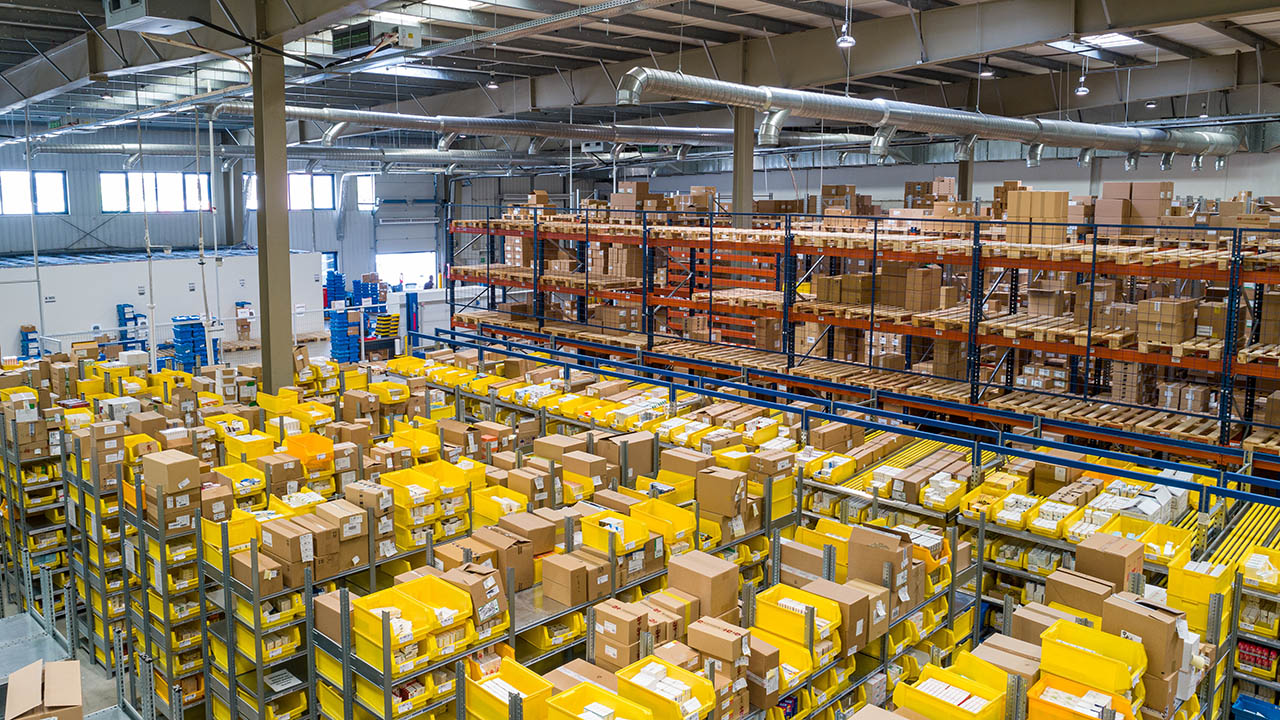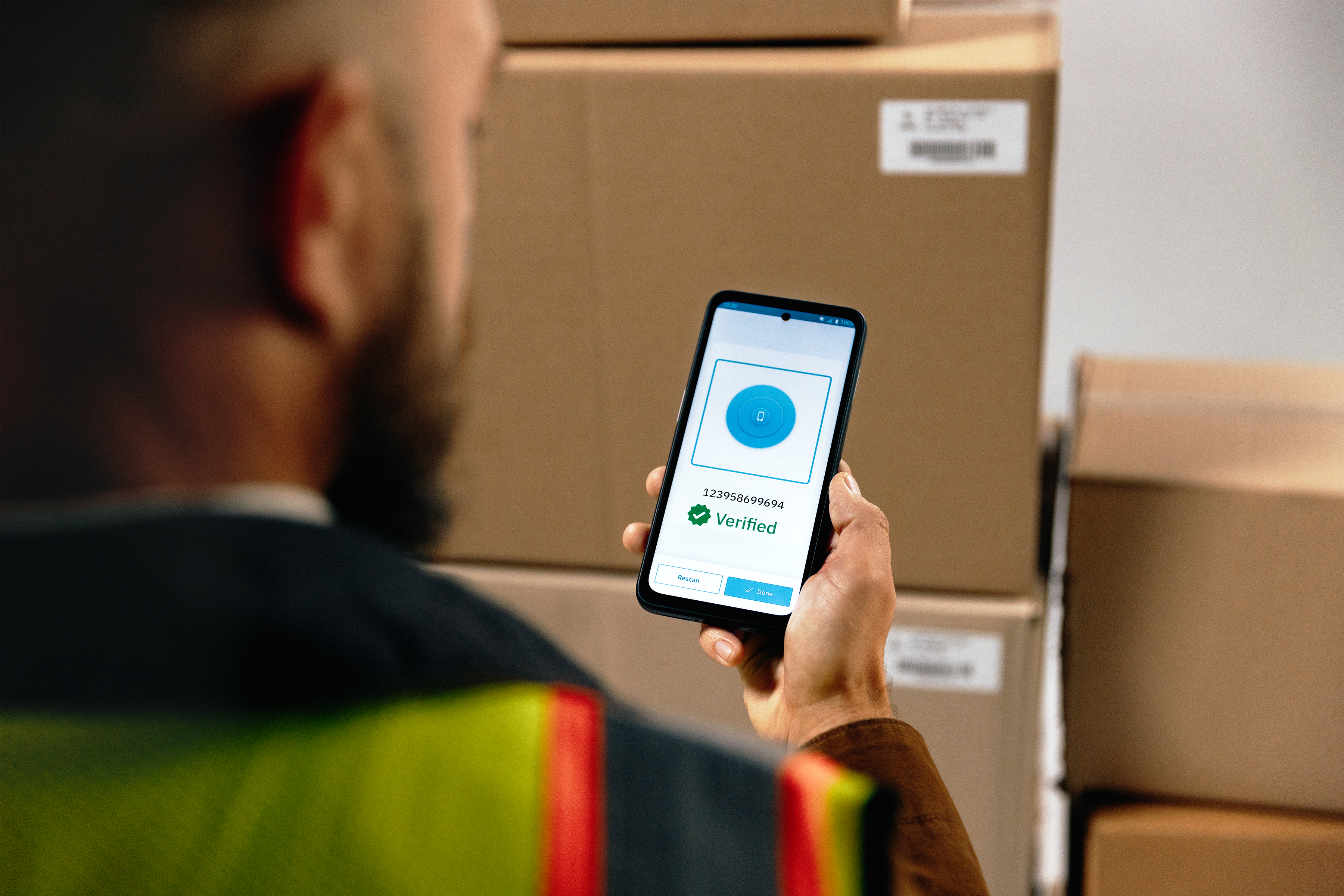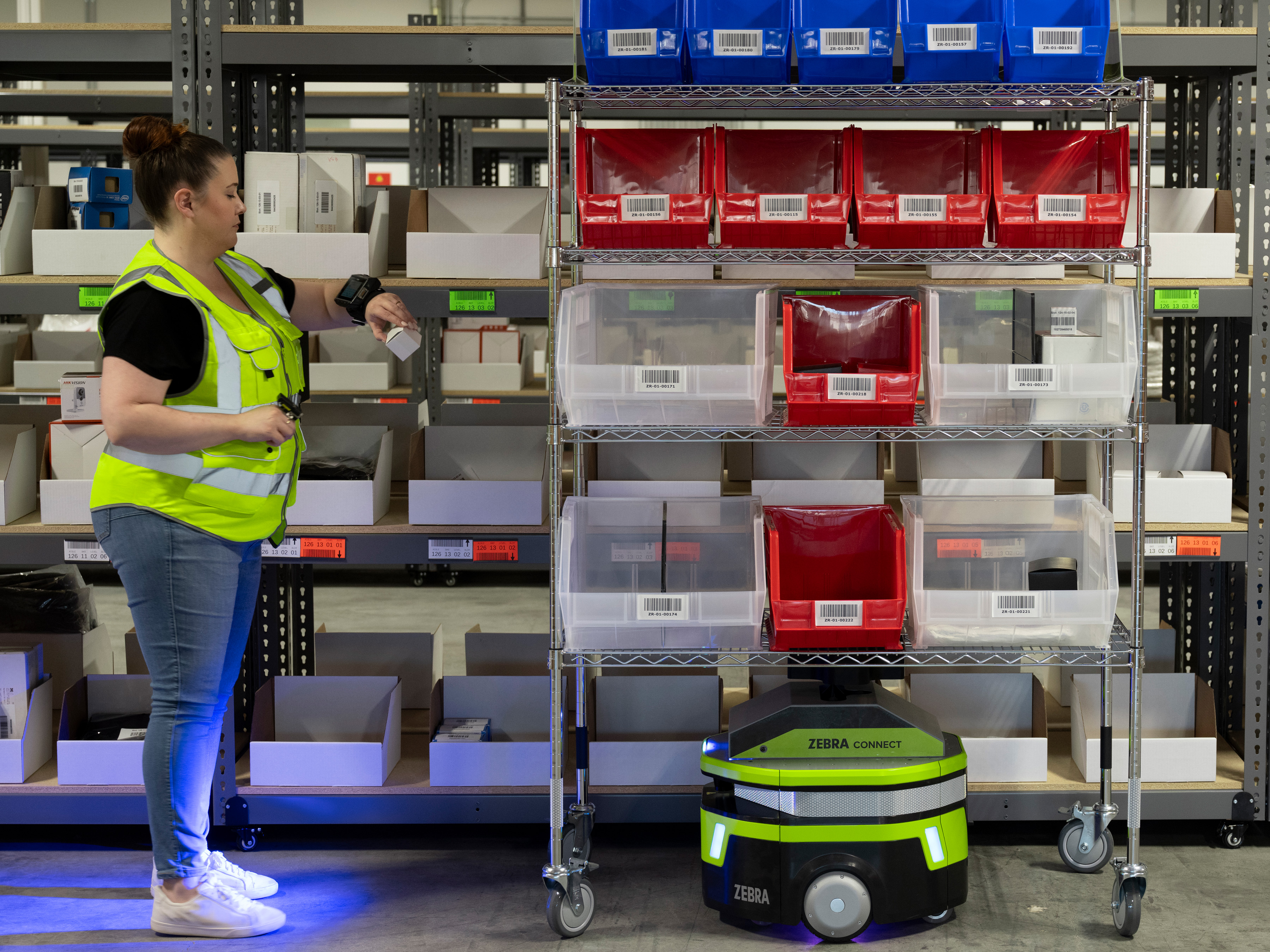Transform retail operations with Zebra’s retail technology solutions, featuring hardware and software for improving inventory management and empowering teams.
Streamline operations with Zebra’s healthcare technology solutions, featuring hardware and software to improve staff collaboration and optimize workflows.
Enhance processes with Zebra’s manufacturing technology solutions, featuring hardware and software for automation, data analysis, and factory connectivity.
Zebra’s transportation and logistics technology solutions feature hardware and software for enhancing route planning, visibility, and automating processes.
Learn how Zebra's public sector technology solutions empower state and local governments to improve efficiency with asset tracking and data capture devices.
Zebra's hospitality technology solutions equip your hotel and restaurant staff to deliver superior customer and guest service through inventory tracking and more.
Zebra's market-leading solutions and products improve customer satisfaction with a lower cost per interaction by keeping service representatives connected with colleagues, customers, management and the tools they use to satisfy customers across the supply chain.
Empower your field workers with purpose-driven mobile technology solutions to help them capture and share critical data in any environment.
Zebra's range of Banking technology solutions enables banks to minimize costs and to increase revenue throughout their branch network. Learn more.
Zebra's range of mobile computers equip your workforce with the devices they need from handhelds and tablets to wearables and vehicle-mounted computers.
Zebra's desktop, mobile, industrial, and portable printers for barcode labels, receipts, RFID tags and cards give you smarter ways to track and manage assets.
Zebra's 1D and 2D corded and cordless barcode scanners anticipate any scanning challenge in a variety of environments, whether retail, healthcare, T&L or manufacturing.
Zebra's extensive range of RAIN RFID readers, antennas, and printers give you consistent and accurate tracking.
Choose Zebra's reliable barcode, RFID and card supplies carefully selected to ensure high performance, print quality, durability and readability.
Zebra's location technologies provide real-time tracking for your organization to better manage and optimize your critical assets and create more efficient workflows.
Zebra's rugged tablets and 2-in-1 laptops are thin and lightweight, yet rugged to work wherever you do on familiar and easy-to-use Windows or Android OS.
With Zebra's family of fixed industrial scanners and machine vision technologies, you can tailor your solutions to your environment and applications.
Zebra’s line of kiosks can meet any self-service or digital signage need, from checking prices and stock on an in-aisle store kiosk to fully-featured kiosks that can be deployed on the wall, counter, desktop or floor in a retail store, hotel, airport check-in gate, physician’s office, local government office and more.
Adapt to market shifts, enhance worker productivity and secure long-term growth with AMRs. Deploy, redeploy and optimize autonomous mobile robots with ease.
Discover Zebra’s range of accessories from chargers, communication cables to cases to help you customize your mobile device for optimal efficiency.
Zebra's environmental sensors monitor temperature-sensitive products, offering data insights on environmental conditions across industry applications.
Enhance frontline operations with Zebra’s AI software solutions, which optimize workflows, streamline processes, and simplify tasks for improved business outcomes.
Zebra Workcloud, enterprise software solutions boost efficiency, cut costs, improve inventory management, simplify communication and optimize resources.
Keep labor costs low, your talent happy and your organization compliant. Create an agile operation that can navigate unexpected schedule changes and customer demand to drive sales, satisfy customers and improve your bottom line.
Drive successful enterprise collaboration with prioritized task notifications and improved communication capabilities for easier team collaboration.
Get full visibility of your inventory and automatically pinpoint leaks across all channels.
Reduce uncertainty when you anticipate market volatility. Predict, plan and stay agile to align inventory with shifting demand.
Drive down costs while driving up employee, security, and network performance with software designed to enhance Zebra's wireless infrastructure and mobile solutions.
Explore Zebra’s printer software to integrate, manage and monitor printers easily, maximizing IT resources and minimizing down time.
Make the most of every stage of your scanning journey from deployment to optimization. Zebra's barcode scanner software lets you keep devices current and adapt them to your business needs for a stronger ROI across the full lifecycle.
RFID development, demonstration and production software and utilities help you build and manage your RFID deployments more efficiently.
RFID development, demonstration and production software and utilities help you build and manage your RFID deployments more efficiently.
Zebra DNA is the industry’s broadest suite of enterprise software that delivers an ideal experience for all during the entire lifetime of every Zebra device.
Advance your digital transformation and execute your strategic plans with the help of the right location and tracking technology.
Boost warehouse and manufacturing operations with Symmetry, an AMR software for fleet management of Autonomous Mobile Robots and streamlined automation workflows.
The Zebra Aurora suite of machine vision software enables users to solve their track-and-trace, vision inspection and industrial automation needs.
Zebra Aurora Focus brings a new level of simplicity to controlling enterprise-wide manufacturing and logistics automation solutions. With this powerful interface, it’s easy to set up, deploy and run Zebra’s Fixed Industrial Scanners and Machine Vision Smart Cameras, eliminating the need for different tools and reducing training and deployment time.
Aurora Imaging Library™, formerly Matrox Imaging Library, machine-vision software development kit (SDK) has a deep collection of tools for image capture, processing, analysis, annotation, display, and archiving. Code-level customization starts here.
Aurora Design Assistant™, formerly Matrox Design Assistant, integrated development environment (IDE) is a flowchart-based platform for building machine vision applications, with templates to speed up development and bring solutions online quicker.
Designed for experienced programmers proficient in vision applications, Aurora Vision Library provides the same sophisticated functionality as our Aurora Vision Studio software but presented in programming language.
Aurora Vision Studio, an image processing software for machine & computer vision engineers, allows quick creation, integration & monitoring of powerful OEM vision applications.
Adding innovative tech is critical to your success, but it can be complex and disruptive. Professional Services help you accelerate adoption, and maximize productivity without affecting your workflows, business processes and finances.
Zebra's Managed Service delivers worry-free device management to ensure ultimate uptime for your Zebra Mobile Computers and Printers via dedicated experts.
Find ways you can contact Zebra Technologies’ Support, including Email and Chat, ask a technical question or initiate a Repair Request.
Zebra's Circular Economy Program helps you manage today’s challenges and plan for tomorrow with smart solutions that are good for your budget and the environment.
The Zebra Knowledge Center provides learning expertise that can be tailored to meet the specific needs of your environment.
Zebra has a wide variety of courses to train you and your staff, ranging from scheduled sessions to remote offerings as well as custom tailored to your specific needs.
Build your reputation with Zebra's certification offerings. Zebra offers a variety of options that can help you progress your career path forward.
Build your reputation with Zebra's certification offerings. Zebra offers a variety of options that can help you progress your career path forward.

Don’t Swing Between Just-in-Time and Just-in-Case. (There’s a Better Framework.)
I understand that shortages can drag down revenue, but excess inventory can drag down your bottom line even more. Here’s why.
Whenever a natural disaster causes product shortages, you’ll hear people say that supply chains need to move from just-in-time to just-in-case.
The implication is that the supply chain was too lean and didn’t have enough inventory to meet the unexpectedly rapid increase in demand.
Coming out of the pandemic and other recent events that have disrupted supply chain flows, some companies took this advice and have started building up their just-in-case inventory. But as those triggering events are resolved and urgent demand decreases, I’ve heard that just-in-case inventory is often viewed as excess and obsolete inventory.
In other words, just-in-case inventory can quickly become a drag on financial performance.
Unfortunately, the terms just-in-time and just-in-case are catchy but don’t give us real guidance. Here are two misconceptions that lead us astray.
First, “just-in-time” is now used to just mean keeping a bare minimum amount of inventory. But the idea came out of Toyota’s overall lean manufacturing strategy. In the overall lean manufacturing approach, Toyota’s leaders did hundreds of things that allowed them to run efficiently with low inventories. But if firms just implement low inventories without understanding all the other aspects of the system, it will cause problems.
Second, when some suggest the need for “just-in-case” inventory, it often comes with the hidden assumption that it would have been easy to predict what was needed.
There is a great line toward the end of Goldratt’s The Goal where they are talking about how to win a big deal. The sales leader says “...if we had only had the foresight to build a finished goods inventory of Model 12’s while we had those slow sales months…”
By this point in the book, the lead character is smiling to himself knowing that they have warehouses full of products that they’ll never sell. They never would have guessed to make this product.
Hopp and Spearman’s great textbook Factory Physics suggests a better way to think about this problem in one of its laws: “Variability in any production/operations system will be buffered by some combination of inventory, capacity, or time.”
In other words, you’ll buffer against variability by having inventory, having capacity (to quickly recover when there is a problem), or with time (by making your customers wait for you to recover).
For example, if you don’t buffer against variability by having inventory or extra capacity, it will default to time. (You just won’t be able to meet demand). You don’t get a free pass.
Also, the more variability you have, the larger your buffers need to be.
I think it is important to think about your buffer strategies for normal times vs. natural disaster times.
In normal times, you experience variability because demand forecasts aren’t perfect, machines break down, shipments are late, and so on. In normal times, inventory is a fine buffer. You might keep a few weeks or a few months of supply, but it doesn’t create an unusual drag on your supply chain.
In this case, you don’t reduce inventory by carelessly implementing a just-in-time system. Instead, the observation above suggests that you work to reduce all the sources of variability, and inventory can naturally settle at a lower point without impacting your business. And, by the way, this is what Toyota did over many years.
In natural disaster times, the variability is extremely high. That is, demand for certain products may go up by 10X, or all the ports, factories, suppliers, and/or regions shut down.
It is in these times when I hear the most about just-in-case inventory. But the variability is so high that the amount of inventory that would have been needed could easily turn into a financial problem that threatens the existence of the company if the event doesn’t happen.
That is, if a company builds inventory for these situations, there is a good chance that the inventory will be for the wrong product, go obsolete, be damaged, spoil, or bankrupt the company before it is ever used. For example, Clorox Wipes saw a sudden increase in demand of 500% in 2020. Yet, in 2010, company leaders had started to fill warehouses just in case demand increased by 5X, as that would have been too big of a drag on the company.
Instead, the Factory Physics law offers another way to look at the situation. Since these variability events will happen, we still need to choose the buffer.
Toyota offers a good example. In 2016, the WSJ wrote an article after an earthquake shut down suppliers, causing a production halt. Japan has been hit by a lot of earthquakes. You might think that Toyota would naturally adopt a just-in-case approach.
Nope.
Instead, Toyota was good to have a small buffer of time – company leaders were willing to halt production. And their big investment was in extra capacity. They said: “...we have been focused on how to understand and identify issues in case of a problem, and how quickly we could recover.”
Being able to quickly recover means having alternative sources of supply, having ways to shift production, and making an investment to understand critical suppliers deep in the supply chain. None of this is free, but they thought this was a better investment than excess inventory.
Every case will be different and requires hard work to create a strategy. There are arguments to be made for stockpiling some critical raw materials. But the point is that you shouldn’t shift to just-in-case inventory without thinking through all the ways to build in extra capacity to react to natural disasters.
###
Want to hear more experts' take on how to right-size inventory? Check out these conversations:
- Ask the Experts: Supply Chain Disruptions are Making It Hard to Manage Inventory. But are There Certain Tools or Tactics That Could Make It Easier?
- KAIZEN and the Art of Inventory Improvement
- If You Dread Having “Dead Inventory,” Consider This
- The (New) Best Way to Optimize Inventory Performance in the New Normal
- Retail’s Big Dilemma: Excess Inventory
Zebra Developer Blog
Zebra Developer Blog
Are you a Zebra Developer? Find more technical discussions on our Developer Portal blog.
Zebra Story Hub
Zebra Story Hub
Looking for more expert insights? Visit the Zebra Story Hub for more interviews, news, and industry trend analysis.
Search the Blog
Search the Blog
Use the below link to search all of our blog posts.
Most Recent
Legal Terms of Use Privacy Policy Supply Chain Transparency
ZEBRA and the stylized Zebra head are trademarks of Zebra Technologies Corp., registered in many jurisdictions worldwide. All other trademarks are the property of their respective owners. ©2025 Zebra Technologies Corp. and/or its affiliates.






